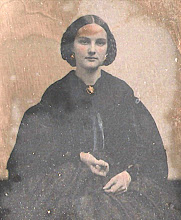Sunday March 2nd
This has been our most delightful day in Rome, we have seen the Catacombs. These dark caves in which the eye of heaven never entered is truly sacred ground. The alters at which our persecuted fathers knelt, the tombs in which their bodies were found, the frescoes on the walls representing the miracles of our Savoiur, which the painter had probably witnessed. Himself who can resist their solemn influence? The catacombs occupy a space of 660 miles under ground. St. Callixtus the one we visited is amongst the finest.
The tomb of Caecilia Metella, wife of Crassus one of the triumverent, not withstanding the purposes it has served is still admirably preserved, and may yet serve as a fort when another civil war breaks out in Rome. We rode over part of the Appian Way where St. Paul speaks of the Romans coming to meet him. Much uncertainity exists about all the monuments, one is believed to be that of Seneca, another that of the Horatii. Near here is supposed to be the spot where the fate of Rome was decided. I believe there is no scene more lovely than the Campagna of Rome. The mountains seem to be ? ? in the azure sky, the aqueducts some in broken niches and others still watering Rome, the ruins scattered over the fields, these are what we dream of as a fairyland , and these are the charms of Rome. The Circus of Caravalla as it shows particularily to the antiquities as it shows the exact plan of the ancient ones. The fountain and woods of the nymph Egeria. Some imperious man says they are the ruins of a Villa but we cannot encourage such impiety, and therefore believe them to be the identical spots where Numa came to consult the goddess.
Tuesday 4th
Mardi gras is the last day of Carnival and in order to have a good view we took seats at the “Caffe Greco”. “Confetti” and bouquets were unmercifully thrown, and the race took place as usual but the great attraction was the “Ma?coli” at dark the whole Corso was illuminated by little wax candles and the excitement consisted in relinquishing as many as you could by throwing bouquets or anything else. There was a good natured fat priest next to me, and we took pleasure in putting out each others candles and then crying “ ? maccoli”.
Thursday 6th
Palazzo Colossa; fine room but few good pictures. In the garden are two immense cornices from the temple of the sun which stood on the Quirinal. Ruins of the baths of Constantine. We passed the church of Gesa(?) where Ignatius Loyola is interred, as it was closed we visited the Palazzo Strada(?) remarkable only for a statue of Pompiez(?) said to be the one at whose feet Caesar fell. This like every thing else in Rome is disputed.
Saturday 8th
Rose at six to go to Tivoli. Pass the baths of Discletien(?) built by the persecuted christians. A few miles from Rome is the lake Tartarus, it waters still petrify, but there are no poets now to celebrate it, and the birds regardless of its properties fly over it. The ancient road to Tivoli (then called Tiber) is still in many places preserved.. Hadrians villa, with its theatres, schools , and baths, was the favourite resort of the emperor, and it was here that most of the fine statues were found. Tivoli a summer retreat of the Romans, still preserves the ruins of fine villas. One is shown as that of Mecaenas the _____? Of letters, another as Horaces, a third as that if Quintilius Varus, the Cicerine assures you all this is true and in order to make it more positive quotes whole lines of Latin verses, We will not dispute the authority, but admire other things which require no ancient names to make them interesting. The “Grotto of Neptune” the Sirens cave, the Cascade and “cascatelles” are formed by the Anis now the Tiverone which separated Tivoli from the country of the Sabines. We dined under the temple of the Sybil (?) better preserved than anything in Rome although many centuries older.
Subscribe to:
Post Comments (Atom)

No comments:
Post a Comment